IJCRR - 7(8), April, 2015
Pages: 45-52
Print Article
Download XML Download PDF
CORRELATES OF AGE AT MENARCHE AMONG UNMARRIED GIRLS IN UT CHANDIGARH
Author: Dinesh Kumar, N. K. Goel, Sonia Puri, Nancy Gupta
Category: Healthcare
Abstract:Background: Age at menarche is an important factor in health planning and reproductive health of females. Studies have indicated that girls are attaining puberty earlier than in the past. Objectives: To explore age at menarche and factors determining it among unmarried girls. Methods: This community based cross-sectional study was conducted in Rural, Urban and Slum strata of UT Chandigarh ,during April 08 to March 09 in total duration of 12 months .Stratified Multistage Random Sampling Design with probability proportional to size (PPS) was utilized. 744 respondents were selected and interviewed by personal interview method to collect desired information. Results and Discussion: The study showed, Maximum respondents 282 (37.9%) were found in the age group 13-15 years followed by 240 (32.3%) in the age group 16-18 years. Maximum number of respondents attained menarche between 13-14 years of age. Mean age at menarche was found to be varying significantly according to type of family (P< 0.001), home environment (P < 0.001), menstrual problems (P=0.03) and menstrual cycle (P=0.001). Respondents whose home environment was not religious, attained menarche significantly earlier (P< 0.001).This study reported several correlates of age at menarche but their
casual relationship could not be established being a cross-sectional study. Menarche an event of the past, was investigated in this study and possibility of recall-bias cannot be ruled out.
Keywords: Multistage random Sampling, Menarche
Full Text:
INTRODUCTION
The age of menarche varies from 9-18 years with the average age in the United States being about 12 years and 8 months whereas in India it is around 12 years1-4.Several studies have documented the importance of environmental factors in the timing of menarche in girls. Sociocultural, environmental, nutritional, and life style related factors are among some potential correlates of age at menarche apart from genetic factors. Eveleth and Tanner (1990)5 , in their review of the sexual development of adolescents worldwide, found that the timing of menarche varies greatly across cultures. A variety of other factors including family conflict, stress and nutrition have also been found to influence the age of menarche. Detailed account of correlates of age at menarche is available in the study by AYATOLLAHI ET AL6 in Iran. With the advancement in modern communication technology, age at menarche is likely to be influenced by exposure to mass media also. There is a need for investigating factors associated with variations in the menarcheal age. The manner in which a girl learns about menstruation and its associated changes may have an impact on her response to the event of menarche. Menstruation is still regarded as something unclean or dirty in Indian society7 . Without prior knowledge, the first menstruation is often horrifying and frightening experience to them8 . Unmarried girls are prone to various reproductive health related problems. Although menstruation is a natural process, it is linked with several misconceptions, ignorance and practices among young girls, which sometimes results into adverse reproductive health outcomes and may adversely affect their daily routine and quality of life9 . Unmarried girls are prone to various menstrual problems like pain and discomfort, heavy bleeding, absence of menstruation and some symptoms related to fluctuating hormone levels like depression, breast tenderness and slight, temporary weight gain. Menstruation disorders are also responsible for emotional, physical, behavioural and dietary practice changes10. Kushwaha and Mittal11 studied the knowledge and attitude of adolescents, but their study was confined to out- of school adolescents attending some training program only and does not reflect their knowledge status in the general community. Despite the fact that menstruation is closely associated with reproductive health matter of females, community based research among unmarried girls on this particular topic has been relatively unexplored. This study aims to explore the various factors determining the age of menarche in adolescent unmarried girls in UT, Chandigarh, The place characterized by high population growth due to increasing migratory population
MATERIALS AND METHODS
744 respondents were selected from different wards/ strata by using Stratified Multistage Random Sampling Design with probability proportional to size (PPS) .Only those unmarried girls who have already attained menarche to find extent of their menstrual problems, perceptions beliefs practices and restrictions and who/ their parents were willing to participate in the study were included.
House-to-house surveys were conducted to collect the desired information. Respondents were interviewed individually in privacy. Interview schedule was finalized after conducting a qualitative survey to explore relevant questions and to get insight of the problem. A well-trained team of female investigators of the department were involved in data collection. Informed consent following Ethical Guidelines of World Medical Association Declaration of Helsinki12 was taken. In case of respondents below 18 years of age, consent from her parents was taken.
STATISTICAL METHODS:
Data analysis was done by using SPSS-12 Software.
RESULTS
Table 1 Maximum respondents (37.9%) were found in the age group 13-15 years followed by 240 (32.3%) in the age group 16-18 years. Overall mean age of respondents was found to be 16.84 years. Maximum respondents 304 (40.9%) were studying in 10th standard while 82 (11.0%) were illiterate and 68.1% were already dropped from their respective schools mostly before 5th standard. Maximum numbers of respondents were from Hindi medium followed by English and Punjabi medium. Respondents were mostly from nuclear families (80.8%). Parents were from different educational categories. Fathers of 119 (16.0%) respondents and mothers of 187(25.1%) were either illiterate or just literate Majority of mothers 433 (58.2%) were house-wives whereas fathers of only 30(4%) were unemployed. Respondents represented different socio economic classes (29.4%) low, (48.9%) middle and (21.6%) of high socio economic status. Mean family size was found to be (5-15±1.67). Table 2 Maximum number of respondents274 (36.8%) attained menarche between 13-14 years of age. Table 3 Majority of respondents 572 (76.9%) were exposed to TV. Against the usual hypothesis of high degree of exposure to internet in highly urbanized city of Chandigarh, it was found to be only among 75 (10.1%) respondents. A total of 448 (60.2%) respondents were having prior knowledge regarding menstruation before attaining menarche and most of these respondents (46.8%) got this knowledge from their mothers followed by their friends (28.3%) and elder sisters (25.9%). Overall mean age at menarche was found to be 13.02 ± 1.13 years. Medium of education, literacy status of mothers were found not to be significantly associated with menarcheal age. Mean age at menarche was found to be varying significantly according to type of family (P< 0.001), home environment (P < 0.001), menstrual problems (P=0.03) and menstrual cycle (P=0.001. Respondents whose home environment was not religious attained menarche significantly earlier (P<0.001) at mean menarcheal age of 12.85 years as compared to those respondents whose home environment was religious attaining menarche at an average of 13.25 years.
DISCUSSION
Mean age at menarche in this study was 13.02 years as compared to 13.6 years in Delhi 13 and 13.5 years in Chennai respectively. Dasgupta and Sarkar (2008)14 reported mean age at menarche to be 12.8 years. The average age of menarche was higher (14 years) in Seagram study15. The mean age at menarche found in this study is consistent with finding of study conducted in Chennai16, report-ing age at menarche to be 13.6 years and it was also consistent with age at menarche of 12.98 years17. Mean age at menarche among Rajasthani Girls is reported to be 13.2 years 18. The median age at menarche measured in a World Health Organization study 20 years ago was 12 years and 09 months, but recent study19 among girls in Hong Kong found that the median age at menarche was 12.1 years. Type of family and home environment were found to be significant correlates of menarcheal age. Menarcheal age influenced menstrual problems and regularity of cycle also, though casual relationship was not attempted in the present study. Body Mass Index (BMI), was significantly correlated with age at menarche (P<0.001). An inverse relationship was found between age at menarche and SES. Several difficulties were faced while conducting the present study. In spite of all necessary measures to tackle non-responses, respondents were reluctant to give answers to some specific questions concerning menstrual cycle. Problems were also faced due to heterogeneity of studied population of Chandigarh including migratory slum population. Different local / regional speaking languages and different terms were being used apart from Hindi, English and Punjabi. Several such problems were tackled on the basis of qualitative survey and with interviewing skills of investigations.
CONCLUSIONS AND SUGGESTIONS
The study has several limitations in terms of study design and inability to do medical investigations / clinical diagnosis. Present study is based on several reported factors of different aspects of menstruations but there casual relationship cannot be established being a cross-sectional study. Also there is possibility of temporal relationship between several correlates. Clinical diagnosis of menstrual problems could not be done in absence of medical investigations not permissible / feasible in the community set-up. Also menstrual problems and misinformation on the part of respondents as well as of their parents particularly mothers can lead to several adverse outcomes on prospective reproductive lives of unmarried girls. Their education, daily routine and social life can also suffer. All these adverse outcomes could not be studied in the present study. Effects of interventional package suggested at different levels are also desired on the basis of some more sophisticated long-terms study designs.
ACKNOWLEDGEMENT
Authors are thankful to Department of Science and Technology (DST), Chandigarh Administration for providing financial assistance for this project. Authors acknowledge the immense help received from the scholars whose articles are cited and included in references of this manuscript. The authors are also grateful to authors/editors/ publishers of all those articles, journals and books from where the literature for this article has been reviewed and discussed.
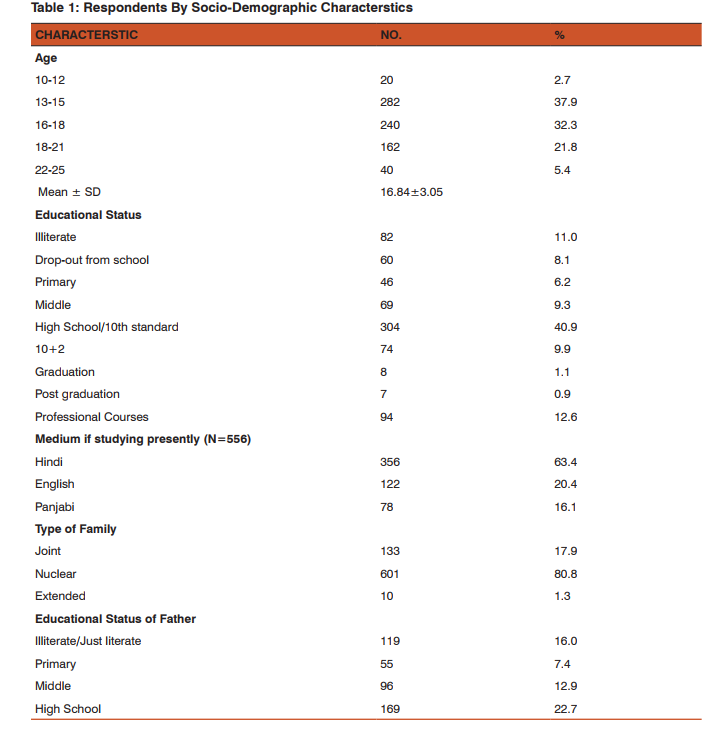
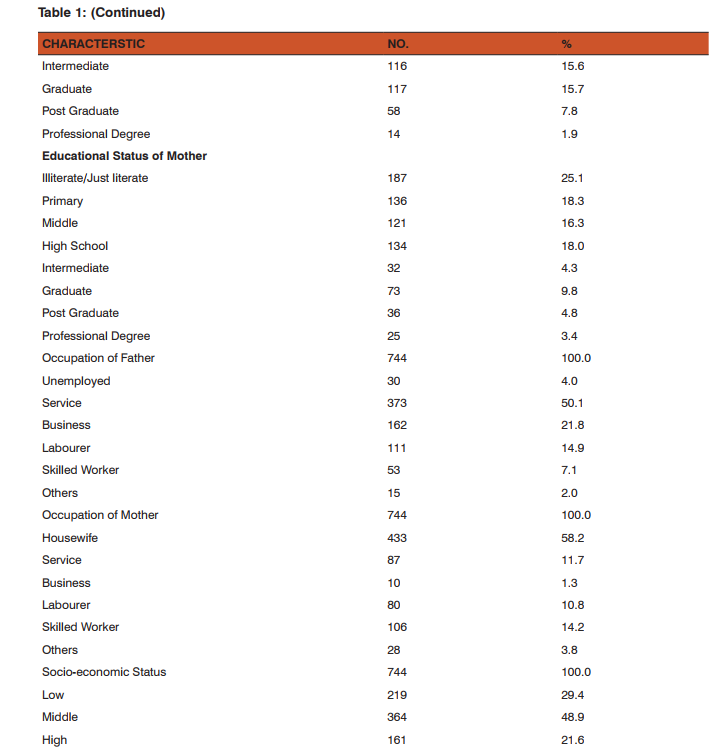



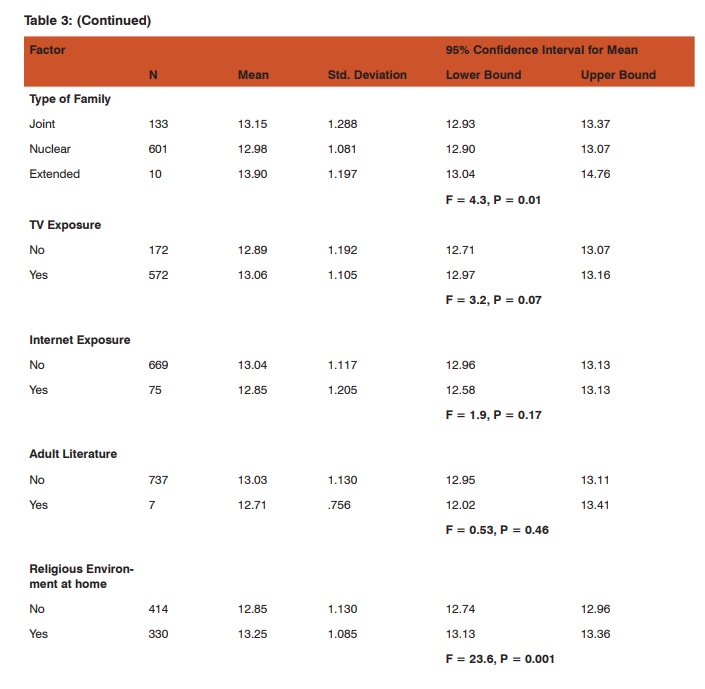
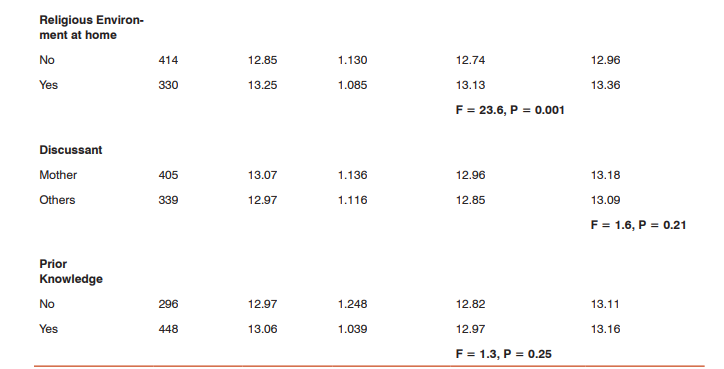
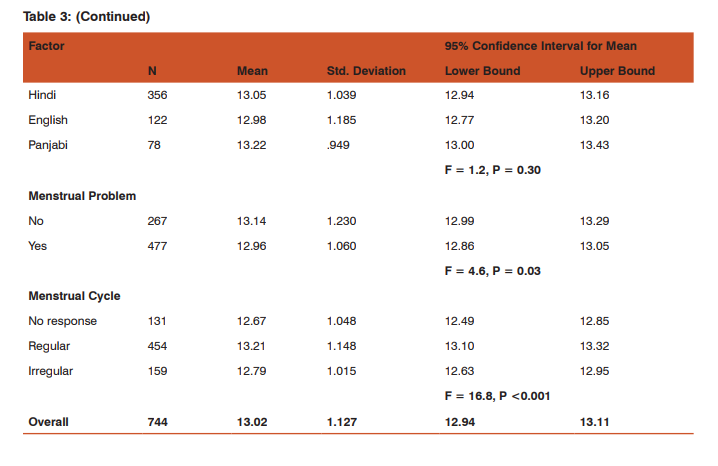
References:
1. Ghiri P, Bernardini M, Vuerich M, Cuttano AM, Coccoli L et al. Adrenarche, pubertal development, age at menarche and final height of full-term, born small for gestational age (SGA) girls. Gynecol Endocrinol 2001; 15: 91-97.
2. Khadilkar VV, Stanhope RG, Khadilkar V. Secular trends in puberty. Indian Pediatr 2006; 43: 475-478.
3. Chumlea WC, Schubert CM, Roche AF, Kulin HE, Lee PA, Himes JH et al. Age at menarche and racial comparisions in US Girls. Pediatrics 2003; 111:110-113.
4. Acharya A, Reddaiah VP, Baridalyne N. Nutritional status and menarche in adolescent girls in an Urban resettlement colony of South Delhi. Indian J Community Medicine.2006; 31:302-303.
5. Eveleth PB, Tanner JM: Worldwide variation in human growth 1976. Cambridge University Press, 1976:213-9.
6. Ayatollahi SMT, E Dowlatabadi, SAR Ayatollahi. Age at menarche and its correlates in Shiraz, Southern Iran. Irn J Med Sci 199; 24(1and 2):20-25.
7. Kamaljit K., Balwinder Arora, Gurmeet Kahlon Singh, N.S. Neki. Social Beliefs and Practices associated with Menstrual Hygiene among Adolescent Girls of Amritsar, Punjab, India. JIMSA April-June 2012 Vol. 25 No. 2
8. H. Tiwari, R. Tiwari, U.N. Oza. Age at Menarche and its Association with Age at Marriage and Age at First Birth. IJCM Vol. 30, No. 1, January-March, 2005.
9. Suman sangita Nayak, Dr.P.K. Mishra. Menstrual Health And Hygiene Education Among Adolescent Girls In Rural Areas By Providing life Skill Education: An Intervention. Life skills education for adolescent reproductive and sexual health issues, 2011.
10. Dinesh Kumar, N.K.Geol, Sonia Puri, Rambha Pathak, Sandeep Singh Sarpal et al. Menstrual Pattern among Unmarried Women from Northern India. J Clin Diagn Res. 2013 Sep; 7(9): 1926–1929.
11. Kushwaha SS, Mittal A. Perceptions and Practice with Regard to Reproductive Health Among Out-of- School Adolescents, Indian Journal of Community Medicine (2007); 32(2):141–43.
12. World Medical Association Declaration of Helsinki: Recommendations guiding physicians in biomedical research involving human subjects 2006 version.
13. Nair P, Grover VL and Kanan AT. Awareness and Practices of Menstruation and Pubertal Changes Amongest unmarried Female Adolescents in Rural Area of East Delhi. Indian Journal of Community Med (2007); 32(2):156-57.
14. Dasgupta A, Sarkar M. Menstrual Hygiene: How Hygienic is the Adolescent Girl. Ind J Community Med 2008; 33(2):77-80.
15. AR Dongre, Deshmukh P.R. and BS Garg. The effect of community-based health education intervention on management of menstrual hygiene among Rural Indian Adolescent Girls. Dr Sushila Nayar School of Public Health, Mahatma Gandhi Institute of Medical Sciences, Sewagram - 442 102, India.
16. Shiela W, Malathy K, Premila S. Menstrual and gynecological disorders in 500 school girls in Madras City. J Obstet Gynaecol India 1993;43: 940-5.
17. Richa Kushwaha. Socio-cultural and Nutritional aspects of menarche among adolescent girls. M.Sc Nutritional Sciences, Dissertation,University of Allahabad, 2004.
18. Khanna A, Goyal RS, Bhawsar R. Menstrual practices and reproductive problems: a study of adolescent girl in Rajasthan. J Health Management 2005; 7:91-107.
19. HK girls with menstrual problems rarely seek medical help: February issue of Hong Kong Medical Journal 2009-02-06 19:15:33.
|






 This work is licensed under a Creative Commons Attribution-NonCommercial 4.0 International License
This work is licensed under a Creative Commons Attribution-NonCommercial 4.0 International License